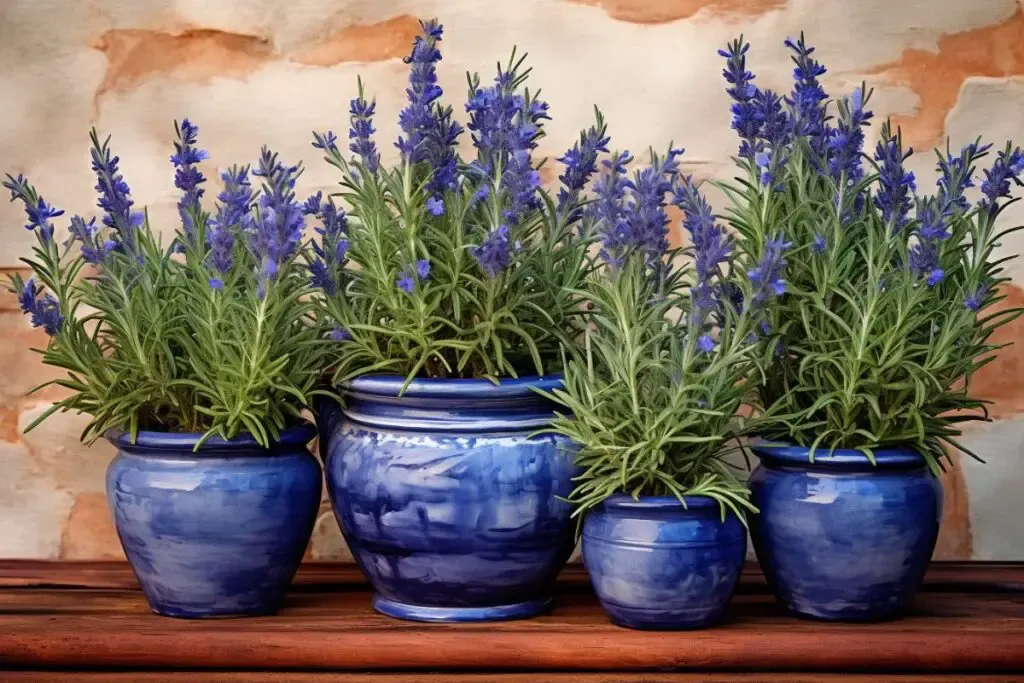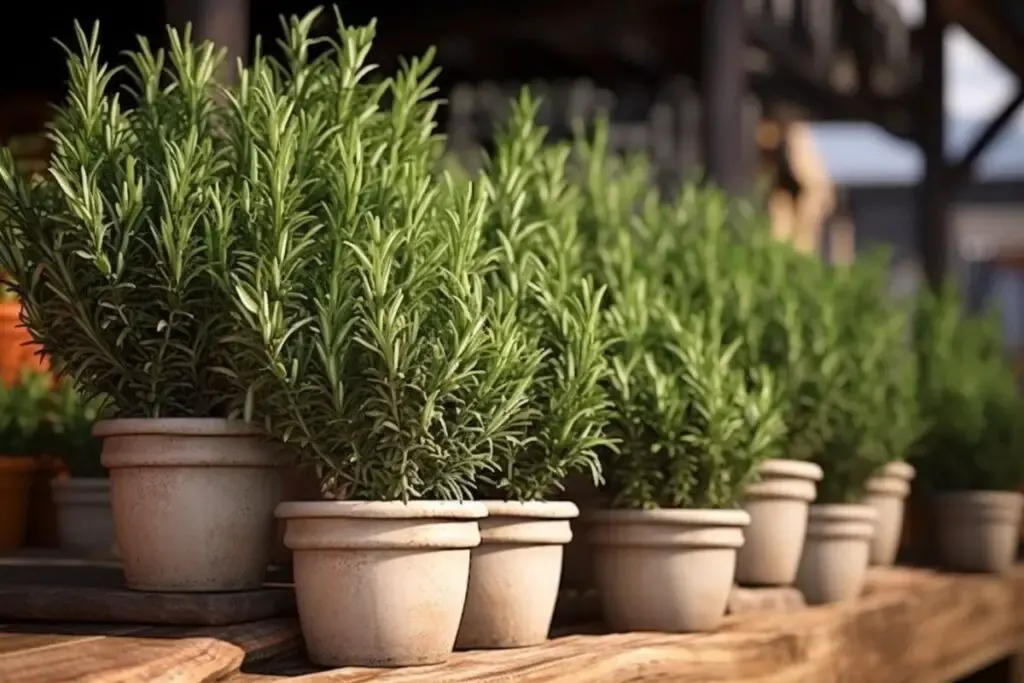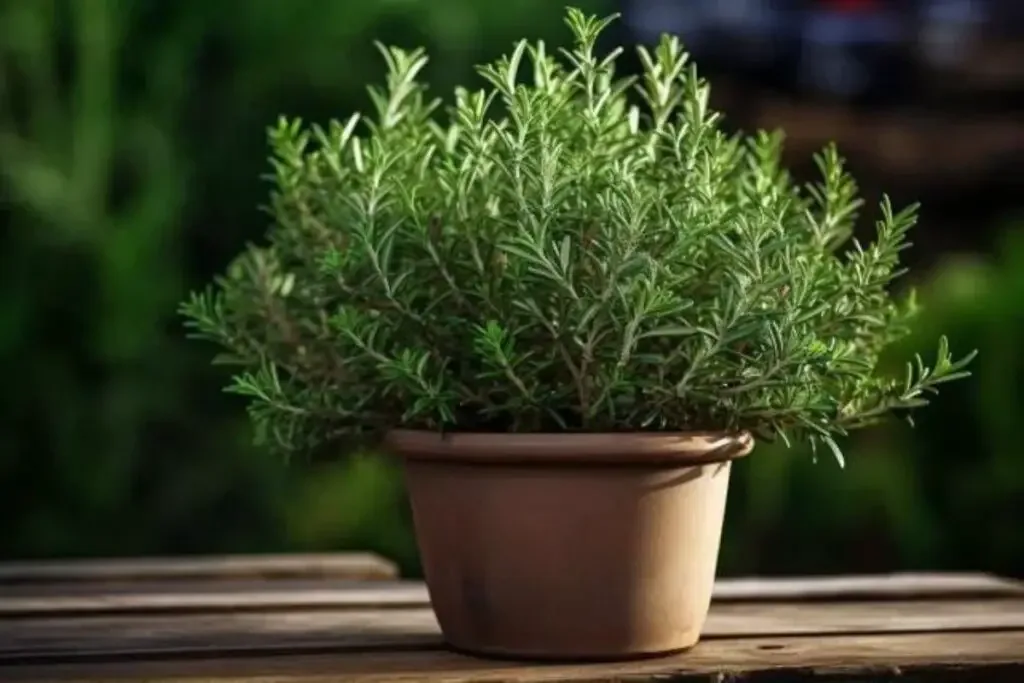Creating a fragrant and lush corner in your home can be as simple as potting a hardy herb like rosemary. Known for its robust flavor and delightful scent, rosemary is not just a culinary staple but also a charming addition to your potted garden collection.
As a gardening enthusiast who’s navigated the ins and outs of herb cultivation, I’ll guide you through the process of growing rosemary in pots, ensuring that even beginners can achieve expert-level success.
So let’s dig in and get our hands dirty—or in this case, a little bit aromatic!
Does Rosemary Grow Well in Pots?
Absolutely! Rosemary is an incredibly versatile herb that adapts well to pot cultivation. Its preference for well-draining soil, coupled with moderate water and abundant sunshine, makes it an ideal candidate for container gardening.
The key to growing rosemary in pots is to mimic its natural Mediterranean habitat as closely as possible. This means plenty of sunlight—aim for at least six to eight hours of direct sun daily—and regular watering, ensuring that the soil doesn’t stay soggy.
In a pot, rosemary roots are more restricted than in the ground, which is why choosing a suitable container is paramount. A pot that’s too small can stunt growth, while one that’s too large can lead to water retention and root rot.
My personal recommendation is a terracotta pot with a drainage hole, which offers breathability and just the right amount of moisture control for the herb to thrive.
When it comes to overwintering, rosemary’s hardiness can withstand cooler temperatures, but it’s not a fan of the freeze. If you’re in a region with harsh winters, consider bringing your potted rosemary indoors to a sunny spot to keep it green and growing.
Best Rosemary Varieties for Pots
Not all rosemary is created equal, especially when it comes to pot growth. There are varieties that naturally grow in a more compact form, making them excellent contenders for your container garden.
Let’s explore some of the best types that are not only tailor-made for pot life but also possess their own unique characteristics.
1. Tuscan Blue

Tuscan Blue is the archetype of rosemary, with its upright growth habit and striking, deep blue flowers that can add a dash of color to any balcony or patio. It reaches a height of about 2-3 feet, which makes it a perfect fit for a medium-sized pot.
Its tall, elegant stems are not just beautiful but also robust in flavor, making it a top pick for culinary use. As someone who enjoys snipping fresh herbs right from the pot, Tuscan Blue has never disappointed—its intense aroma is as intoxicating as its flavor is profound.
2. Gorizia

Gorizia rosemary is notable for its broad, flat leaves, which are larger than those of most other varieties. This feature makes it not only a visual standout but also a pleasure to harvest and use in the kitchen.
Originating from the Italian town it’s named after, Gorizia has a somewhat more open, less dense growth habit, but don’t let that fool you—it’s just as sturdy and fragrant.
It’s a joy to brush your fingers through the foliage and release its aromatic oils, which is why I always recommend Gorizia to those who love both form and function in their herbs.
3. Prostratus

The Prostratus, or creeping rosemary, is the go-to for gardeners looking for a trailing variety. Its stems cascade beautifully over the sides of pots, making it an excellent choice for elevated planters or window boxes.
While it’s a champion in the looks department, it doesn’t fall short in flavor either. The Prostratus is hardy, drought-resistant, and loves to bask in the full sun, just like its upright cousins.
When left to its own devices, it creates a sprawling display of greenery that’s as effective at seasoning dishes as it is at draping your space in texture and fragrance.
How to Grow and Care For Rosemary in Pots
Growing rosemary in pots not only adds a visual charm to your space but also ensures a steady supply of this fragrant herb.
To make sure your potted rosemary plants are the envy of your neighbors, let’s walk through the essentials of planting and care.
Planting
The planting process sets the stage for your rosemary’s life in a pot. Start with a healthy, vibrant young plant from a reputable nursery. Early spring is often the best time to pot rosemary because the moderate temperatures help the plant establish itself.
When transplanting, be gentle with the roots to avoid shock. I always talk to my plants during this stage—it’s a personal quirk, but I swear they appreciate the encouragement!
Pot Size
Size matters when it comes to pots. Rosemary likes to be cozy but not cramped. A 12-inch diameter pot is a good starting point for one plant.
As the rosemary grows, it may need to be repotted to a larger container to prevent it from becoming root-bound. I find that repotting every couple of years keeps my rosemary happy and healthy.
Light
Sunshine is to rosemary what applause is to performers—absolutely necessary. This herb thrives on full sun, requiring at least 6-8 hours of direct light daily.
If you’re growing indoors, a south-facing window is ideal. Rotate the pot regularly to ensure even growth, because, like us, plants also need balance in life.
Soil
Well-draining soil is non-negotiable for rosemary. I recommend a mix designed for cacti or succulents, which ensures proper drainage and aeration.
You can also create your own mix with equal parts potting soil, coarse sand, and perlite or peat moss. This combination mimics the sandy soil rosemary loves in its natural habitat.
Water
Overwatering is the fast track to a sad, wilted rosemary plant. Allow the soil to dry out between watering, and when you do water, do it thoroughly until it runs out of the drainage holes.
I like to let my rosemary play a bit of a ‘thirst game’—it builds character and resilience!
Temperature and Humidity
Rosemary is a hardy soul that prefers cooler temperatures and low humidity, similar to its Mediterranean origins. Indoor rosemary plants should be kept in a cool room, especially during the winter months, to mimic the natural dormancy period. If the air in your home is dry, your rosemary will be quite content.
Fertilizer
Feeding your rosemary is like giving it a little boost—a little goes a long way. Use a half-strength liquid fertilizer once in the spring and once in mid-summer.
Avoid over-fertilizing, as rosemary’s flavor is most intense when it’s grown in lean, slightly nutrient-deficient soil.
Pruning Potted Rosemary
Pruning is an essential step in caring for potted rosemary, both for maintaining its shape and encouraging lush, bushy growth. Regular trimming keeps the plant from becoming leggy and woody.
As an avid gardener, I find pruning to be a therapeutic ritual. I recommend pruning in the spring to remove any dead or woody stems and to shape the plant. It’s like giving your rosemary a haircut to enhance its form and vigor.
Don’t be shy about cutting back up to a third of the plant; rosemary is resilient and will bounce back with fuller growth. Use clean, sharp scissors or pruners to make clean cuts. This not only keeps the plant healthy but also provides you with fresh herbs for cooking. And who doesn’t love a homegrown addition to their culinary creations?
Overwintering
If you live in a region with cold winters, overwintering your potted rosemary is crucial. This herb does not tolerate freezing temperatures well and should be brought indoors before the first frost. I find the transition indoors is smoother if I gradually acclimate the plant to lower light conditions.
Once inside, place the rosemary in a cool spot with plenty of sunlight, like a south-facing window, and reduce watering. The goal is to keep the plant alive but dormant.
You may also use a grow light to supplement light, especially during the darker winter days. Remember, the drier and cooler the conditions, the happier the rosemary will be.
During this period, hold back on fertilizing and pruning sparingly, only to remove dead or diseased foliage. By spring, your rosemary will be ready to return outdoors and start the season afresh, a testament to your careful tending through the winter months.

